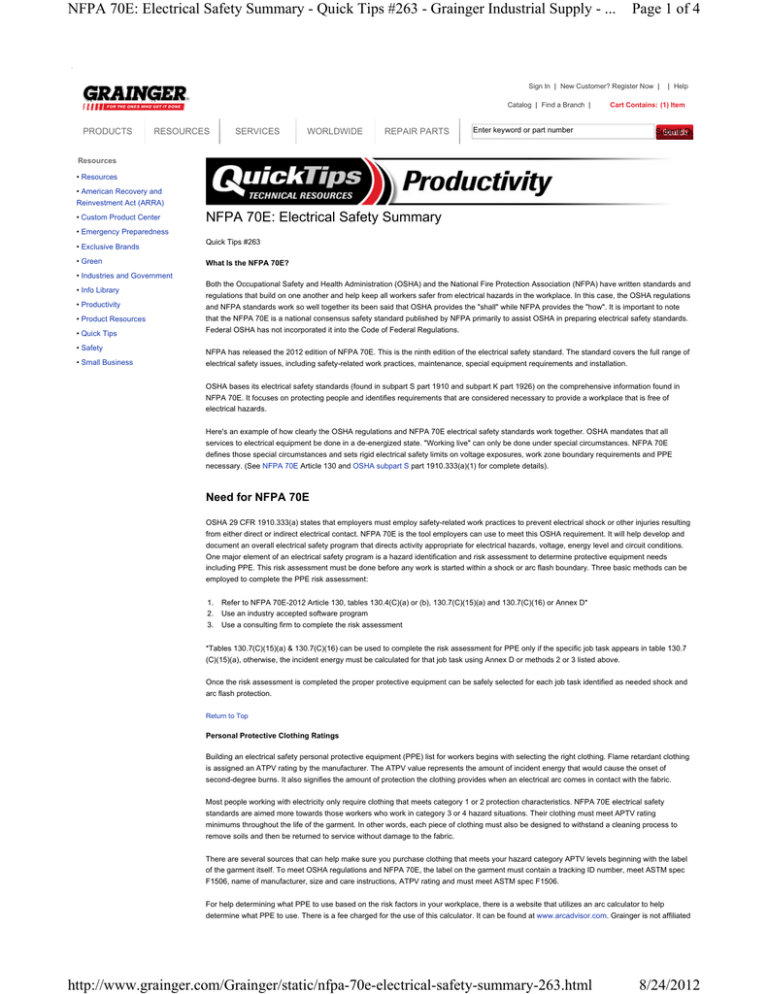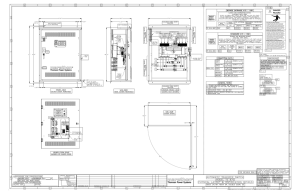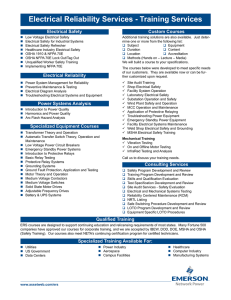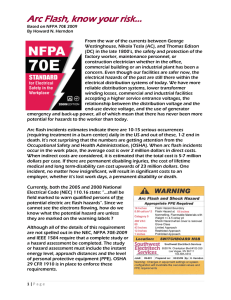
NFPA 70E: Electrical Safety Summary - Quick Tips #263 - Grainger Industrial Supply - ...
Page 1 of 4
tS ko i: p
t,S ko i: p
t,S ko i: p
Sign In | New Customer? Register Now |
Catalog | Find a Branch |
PRODUCTS
RESOURCES
SERVICES
WORLDWIDE
REPAIR PARTS
| Help
Cart Contains: (1) Item
Enter keyword or part number
Submit Qu
Resources
• Resources
• American Recovery and
Reinvestment Act (ARRA)
• Custom Product Center
NFPA 70E: Electrical Safety Summary
• Emergency Preparedness
• Exclusive Brands
• Green
Quick Tips #263
What Is the NFPA 70E?
• Industries and Government
• Info Library
Both the Occupational Safety and Health Administration (OSHA) and the National Fire Protection Association (NFPA) have written standards and
• Productivity
regulations that build on one another and help keep all workers safer from electrical hazards in the workplace. In this case, the OSHA regulations
and NFPA standards work so well together its been said that OSHA provides the "shall" while NFPA provides the "how". It is important to note
• Product Resources
that the NFPA 70E is a national consensus safety standard published by NFPA primarily to assist OSHA in preparing electrical safety standards.
• Quick Tips
• Safety
• Small Business
Federal OSHA has not incorporated it into the Code of Federal Regulations.
NFPA has released the 2012 edition of NFPA 70E. This is the ninth edition of the electrical safety standard. The standard covers the full range of
electrical safety issues, including safety-related work practices, maintenance, special equipment requirements and installation.
OSHA bases its electrical safety standards (found in subpart S part 1910 and subpart K part 1926) on the comprehensive information found in
NFPA 70E. It focuses on protecting people and identifies requirements that are considered necessary to provide a workplace that is free of
electrical hazards.
Here's an example of how clearly the OSHA regulations and NFPA 70E electrical safety standards work together. OSHA mandates that all
services to electrical equipment be done in a de-energized state. "Working live" can only be done under special circumstances. NFPA 70E
defines those special circumstances and sets rigid electrical safety limits on voltage exposures, work zone boundary requirements and PPE
necessary. (See NFPA 70E Article 130 and OSHA subpart S part 1910.333(a)(1) for complete details).
Need for NFPA 70E
OSHA 29 CFR 1910.333(a) states that employers must employ safety-related work practices to prevent electrical shock or other injuries resulting
from either direct or indirect electrical contact. NFPA 70E is the tool employers can use to meet this OSHA requirement. It will help develop and
document an overall electrical safety program that directs activity appropriate for electrical hazards, voltage, energy level and circuit conditions.
One major element of an electrical safety program is a hazard identification and risk assessment to determine protective equipment needs
including PPE. This risk assessment must be done before any work is started within a shock or arc flash boundary. Three basic methods can be
employed to complete the PPE risk assessment:
1.
Refer to NFPA 70E-2012 Article 130, tables 130.4(C)(a) or (b), 130.7(C)(15)(a) and 130.7(C)(16) or Annex D*
2.
Use an industry accepted software program
3.
Use a consulting firm to complete the risk assessment
*Tables 130.7(C)(15)(a) & 130.7(C)(16) can be used to complete the risk assessment for PPE only if the specific job task appears in table 130.7
(C)(15)(a), otherwise, the incident energy must be calculated for that job task using Annex D or methods 2 or 3 listed above.
Once the risk assessment is completed the proper protective equipment can be safely selected for each job task identified as needed shock and
arc flash protection.
Return to Top
Personal Protective Clothing Ratings
Building an electrical safety personal protective equipment (PPE) list for workers begins with selecting the right clothing. Flame retardant clothing
is assigned an ATPV rating by the manufacturer. The ATPV value represents the amount of incident energy that would cause the onset of
second-degree burns. It also signifies the amount of protection the clothing provides when an electrical arc comes in contact with the fabric.
Most people working with electricity only require clothing that meets category 1 or 2 protection characteristics. NFPA 70E electrical safety
standards are aimed more towards those workers who work in category 3 or 4 hazard situations. Their clothing must meet APTV rating
minimums throughout the life of the garment. In other words, each piece of clothing must also be designed to withstand a cleaning process to
remove soils and then be returned to service without damage to the fabric.
There are several sources that can help make sure you purchase clothing that meets your hazard category APTV levels beginning with the label
of the garment itself. To meet OSHA regulations and NFPA 70E, the label on the garment must contain a tracking ID number, meet ASTM spec
F1506, name of manufacturer, size and care instructions, ATPV rating and must meet ASTM spec F1506.
For help determining what PPE to use based on the risk factors in your workplace, there is a website that utilizes an arc calculator to help
determine what PPE to use. There is a fee charged for the use of this calculator. It can be found at www.arcadvisor.com. Grainger is not affiliated
http://www.grainger.com/Grainger/static/nfpa-70e-electrical-safety-summary-263.html
8/24/2012
NFPA 70E: Electrical Safety Summary - Quick Tips #263 - Grainger Industrial Supply - ...
Page 2 of 4
with www.arcadvisor.com and is referring to this website as a reference only.
Return to Top
Regulation Changes
In 2012, the NFPA released the ninth edition of the 70E standard for electrical safety in the workplace based on the 2011 NFPA 70 (NEC) Code.
The previous edition was published in 2009. There are significant differences between the two editions.
The original NEC Code was written primarily for those who design, install and inspect electrical installations (electricians by trade). Its technical
content, complexity and scope are specific to the needs of that group and include provisions that have nothing to do with employee safety.
OSHA's responsibility, on the other hand, is to ensure its regulations on electrical safety pertain to employers/employees across industry lines.
The NFPA 70E was created to fulfill OSHA requirements while remaining consistent with original NEC Code. It is drawn largely from the original
code, but also from other documents to make it more understandable and usable across the board.
Here are highlights of changes from the 2009 70E edition to the 2012 70E edition:
1.
Updated to correlate with the latest NEC code—2011
2.
Definitions of terms not used deleted
3.
Term "Flame-resistant" replaced by "arc-rated" (AR)
4.
5.
New Article 105, Application of Safety-Related Work Practices separated from Article 110
Three year retraining interval
6.
Safe work practices added for use with GFCI's
7.
Article 110.8 moved to Article 130.3
8.
9.
New safety-related work practice for underground electrical lines
Individual qualified employee control procedure added
10.
All requirements of Article 130 required whether hazard/risk table or hazard risk analysis used
11.
New requirements and info regarding PPE use associated with enclosed electrical equipment
12.
13.
Content of energized electrical work permit revised
Hazard/Risk tables analysis added to address DC current
14.
Hearing protection required within arc flash boundary
15.
Arc-Flash protection for hands has been revised to specify "heavy-duty" leather gloves
16.
17.
Hazard/risk tables now address short-circuit current, fault clearing, and potential arc flash boundary info in each major category
Hazard/Risk table modified to eliminate 2* category and combines old tables 130.7(C)(10) & (11) into one table 130.7(C)(16)
18.
New equipment labeling requirements
19.
Documented meeting between the host employer and the contract employer
Return to Top
PPE and Hazard/Risk Table
NFPA added specific reference information addressing the use of PPE as a safe work practice around shock and arc flash hazards. As
highlighted in numbers 11–17 above several changes were made to this edition to ensure PPE is more appropriately selected. The biggest
change involves the new hazard/risk table being developed (#17 above). Once the hazard/risk category has been identified from table 130.7(C)
(15)(a) and/or (b) and requirements of 130.7(C)(15) have been met, table 130.7(C)(16) will be used to determine the required PPE for the task.
This method can only be used of the specific job task appears in the table.
Protective Clothing and Personal Protective Equipment Table 130.7(C)(16)
Minimum APTV
Hazard/Risk
Category*
Clothing Description
Rating Cal/cm2 Required Garments
0
Nonmelting or untreated natural Fiber
(i.e., cotton, wool, rayon or silk, or
blends of these materials) with a fabric
weight of at least 4.5 oz/yd22
0
1
Arc-rated clothing
(see note 3)
4
2
Arc-rated clothing
(see note 3)
8
3
Arc-eated clothing system
(see note 3)
25
4
Arc-rated clothing system
(see note 3)
40
Required Protective Equipment
Safety glasses or safety goggles
(SR)
Shirt (long sleeve)
Hearing protection (ear canal
Pants (long)
inserts)
Heavy duty leather gloves (AN)
(see note 1)
Hard hat
Shirt (long sleeve) and pants
Safety glasses or goggles (SR)
(long) or coverall
Hearing protection (ear canal
Flash suit hood or faceshield (see
inserts)
note 2)
Heavy duty leather gloves (see
Jacket, parka, rainwear, or
note 1)
hardhat liner (AN)
Leather work shoes (AN)
Hard hat
Shirt (long sleeve) and pants
Safety glasses or goggles (SR)
(long) or coverall
Hearing protection (ear canal
Flash suit hood or faceshield (see
inserts)
note 2) and balaclava
Heavy duty leather gloves (see
Jacket, parka, rainwear, or
note 1)
hardhat liner (AN)
Leather work shoes
Shirt (long sleeve) (AR)
Pants (long) (AR)
Hard hat
Coverall (AR)
Safety glasses or safety goggles
Flash suit jacket (AR)
(SR)
Flash suit pants (AR)
Hearing protection (ear canal
Flash suit hood
inserts)
Gloves (see note 1)
Leather work shoes
Jacket, parka, rainwear, or hard
hat liner (AN)
Shirt (long sleeve) (AR)
Pants (long) (AR)
Coverall (AR)
Flash suit jacket (AR)
Flash suit pants (AR)
Hard hat
Safety glasses or safety goggles
(SR)
Hearing protection (ear canal
http://www.grainger.com/Grainger/static/nfpa-70e-electrical-safety-summary-263.html
8/24/2012
NFPA 70E: Electrical Safety Summary - Quick Tips #263 - Grainger Industrial Supply - ...
Flash suit hood
Gloves (see note 1)
Jacket, parka, rainwear, or hard
hat liner (AN)
Page 3 of 4
inserts)
Leather work shoes
AN = as needed (optional)
AR = as required
SR = selection required
*One of the 3 basic methods is used to determine a HRC for a job task
Notes:
(1) If rubber insulating gloves with leather protectors are required by table 130.7(C)(9), additional leather or arc-rated gloves are not required.
The combination of rubber insulating gloves with leather protectors satisfies the arc flash protection requirement.
(2) Face shields are to have wrap-around guarding to protect not only the face but also the forehead, ears and neck, or, alternatively, an arcrated arc flash suit hood is required to be worn.
(3) Arc rating is defined in article 100 and can be either the arc thermal performance value (ATPV) or energy of break open threshold (EBT).
ATPV is defined in ASTM F 1959, standard test method for determining the arc thermal performance value of materials for clothing, as the
incident energy on a material, or a multilayer system of materials, that results in a 50% probability that sufficient heat transfer through the tested
specimen is predicted to cause the onset of a second-degree skin burn injury based on the stoll curve, in cal/cm2. EBT is defined in ASTM F
1959 as the incident energy on a material or material system that results in a 50% probability of breakopen. Arc rating is reported as either ATPV
or EBT, whichever is the lower value.
Return to Top
Labeling Electrical Hazards
As highlighted in #18 above new equipment labeling requirements were added to the 2012 edition of NFPA 70E (130.5(C)). This will require
employers to field mark electrical equipment as part of their arc flash analysis. Examples of equipment that would require field marking would be
switchboards, panelboards, industrial control panels, meter socket enclosures and motor control centers. The label must contain the following
information:
1.
At least one of the following:
a. Available incident energy and the corresponding distance
b. Minimum arc rating of clothing
c. Required level of PPE
d. Highest Hazard/Risk Category (HRC) for the equipment
2.
3.
Nominal system voltage
Arc flash boundary
The method of calculation and data to support the information for the label field marking must be documented. NFPA is allowing an exemption for
all labels applied prior to September 30, 2011 will be acceptable.
Example of current label:
Arc Safety Label
Return to Top
Frequently Asked Questions
Q. How do I determine what level of protection I need for my job task?
A. There are 3 basic methods that can be used to determine level of protection:
1.
Refer to NFPA 70E-2012 article 130, tables 130.4(C)(a) or (b), 130.7(C)(15)(a), and 130.7(C)(16) or annex D*
2.
Use an industry accepted software program
3.
Use a consulting firm to complete the risk assessment
*Tables 130.7(C)(15)(a) & 130.7(C)(16) can be used to complete the risk assessment for PPE only if the specific job task appears in table 130.7
(C)(15)(a), otherwise, the incident energy must be calculated for that job task using annex D or methods 2 or 3 listed above.
Q. What if my job task is not listed in table 130.7(C)(15)(a) of NFPA 70E-2012 electrical safety standard?
A. The incident energy must be calcuated for the job task. Annex D of the NFPA 70E-2012 standard can be referenced or use an approved
online arc calculator like the Duke Flux calculator.
Q. Is compliance with NFPA 70E electrical safety standard mandatory?
A. No, NFPA 70E is a national consensus safety standard published by NFPA primarily to assist OSHA in preparing electrical safety standards.
Federal OSHA has not incorporated it into the Code of Federal Regulations.
Q. Can I be cited for not complying with NFPA 70E?
A. Yes, the employer must assess the workplace for electrical hazards and the need for PPE under 29 CFR 1910.335(a)(1)(i). Details on how to
comply with this standard are left up to the employer. The employer is expected to use the best means available to comply with this requirement,
http://www.grainger.com/Grainger/static/nfpa-70e-electrical-safety-summary-263.html
8/24/2012
NFPA 70E: Electrical Safety Summary - Quick Tips #263 - Grainger Industrial Supply - ...
Page 4 of 4
and that is done through consensus standard NFPA 70E. Compliance with 70E will assure compliance with this OSHA requirement. In the event
of an injury or death due to an electrical accident, if OSHA determines that compliance with 70E electrical safety standard would have prevented
or lessened the injury, OSHA may cite the employer under the general duty clause. In 2003 standards interpretation letter OSHA stated 70E
electrical safety standard can be used as evidence of whether the employer acted reasonably.
Return to Top
Sources
NFPA 70E-2012 Standard for Electrical Safety Requirements for Employee Workplaces, National Fire Protection Association, 1-617-770-3000.
ASTM F1506 Standard, American Society for Testing Materials, 1-610-832-9585.
Occupational Safety & Health Administation (OSHA), www.osha.gov.
Duke Power Flux Calculator. Available at Oberon:
http://www.arcflash.com/
Return to Top
Related Articles
Quick Tips #100: Understanding ANSI, ASTM International, FM Global, NFPA, SEI and UL
Quick Tips #101: Multimeter Functions
Quick Tips #170: Lockout/Tagout, 29 CFR 1910.147
Quick Tips #204: Insulated Hand Tools
Quick Tips #262: Electrical Safety Gloves: Inspection and Classification
Quick Tips #266: Electrical Safety
Return to Top
(Rev. 1/2012)
Find even more information you can use to help make informed decisions about the regulatory issues you face in your workplace every day. View all Quick
Tips Technical Resources at www.grainger.com/quicktips.
Think Safety. Think Grainger.SM
Rely on North America's largest supplier of safety products. You'll also find a network of safety resources that help you stay in compliance and protect
employees from hazardous situations. Count on Grainger for lockout tagout, fall protection equipment, confined space products, safety signs, personal
protective equipment (PPE), emergency response and so much more!
Please Note:
The information contained in this publication is intended for general information purposes only. This publication is not a substitute for review of the applicable
government regulations and standards, and should not be construed as legal advice or opinion. Readers with specific questions should refer to the cited
regulation or consult with an attorney.
©2012 W.W. Grainger, Inc.
Customer Service
Order Support
Company Information
Online Resources
Services
Email Sign Up
Catalog Request
Bulk Order Pad
About Us
Clearance Center
Alliance Energy Solutions®
Get industry news,
Contact Us
Order History
Careers
Exclusive Brands
Emergency Services
Feedback
Order Status
Community Relations
Hot Buys
Inventory Management
new product information,
helpful tips and more.
Find a Branch
Returns
Diversity
Rebates
Online Purchasing Solutions
Site Features
Investor Relations
SupplyLink®
Grainger Online SafetyManager℠
Will Call
Press Room
Today's Features
Products Beyond the Catalog®
Supplier Overview
Webinars
Grainger TripleGuard®
Sustainability
Technical Education
Worldwide
Home | Terms of Access | Terms of Sale | Return Policy | Privacy Policy (Rev. December, 2011) | Sitemap
© 1994 - 2012 W.W. Grainger, Inc. All rights reserved.
http://www.grainger.com/Grainger/static/nfpa-70e-electrical-safety-summary-263.html
8/24/2012





